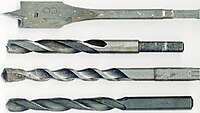
Photo from wikipedia
ABSTRACT This work is focused on the rise in temperature of the workpiece and tool during the drilling of intermetallic titanium aluminide under minimum quantity lubrication (MQL) environment. While drilling… Click to show full abstract
ABSTRACT This work is focused on the rise in temperature of the workpiece and tool during the drilling of intermetallic titanium aluminide under minimum quantity lubrication (MQL) environment. While drilling under MQL condition there was a significant decrease in work surface and drill tool temperature due to the better cooling and lubrication ability of the fluid mist. From the microscopic investigation of machined surface, many surface defects like material pile up, side flow, chip adhesion, etc. were found. The intensity of damage during dry drilling was high when compared to MQL. From the analysis of drill tool, the presence of built-up edge was observed in both high and low aspect ratio drilling due to the high temperature produced during the process which makes the work material vicious. During MQL condition, the excess heat produced at the machining zone is carried away by the cutting fluid supplied as mist thereby controlling the built-up edge formation. The roughness of the flute region of drill tool during MQL was comparable with drill tool under the wet condition. Also, the temperature rise during MQL drilling was substantially low when compared to dry machining.
Journal Title: Materials and Manufacturing Processes
Year Published: 2018
Link to full text (if available)
Share on Social Media: Sign Up to like & get
recommendations!